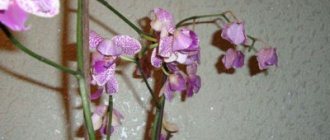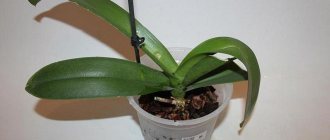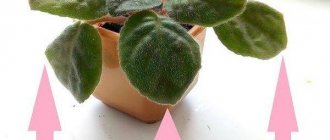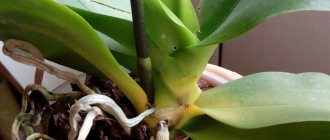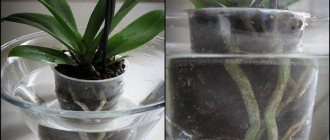Pulling the flower by the stem
The most common mistake when replanting is trying to pull parts of the plant when removing it from a purchased container. You need to carefully pry off the flower using available tools. If necessary, you can tap on the bottom, but it is strictly forbidden to pull on the stem.
After removing the plant, you need to clean the root a little. This will help speed up growth. After this, soil is poured into a new pot, the plant is placed there and soil is added on top. Then water the flower.
What to do if the flower has withered, how to revive it?
Most often, leaves lose turgor due to lack of moisture after transplantation . The problem can be solved with sufficient moisture. To do this, you need to create a mini-greenhouse by covering the spathiphyllum with a transparent film. The flower also requires regular spraying of the foliage. If the leaves are too dry, then you need to moisten the flower with a spray bottle several times a day.
Lack of moisture can also be caused by dense soil, which prevents the rhizomes from feeding with beneficial substances supplied with the liquid. In this case, the plant must be removed from the pot, its roots must be cleared of the lump of earth and transplanted into a new container filled with a drainage layer and light, loose soil.
If the process is too advanced, it is necessary to soak the roots in water for 15-20 minutes before transplanting. It is advisable to immerse the entire plant along with the leaves in water.
Spathiphyllum may also react negatively to too dry indoor air . To increase the humidity level, you need to place a container of water next to the flower; an aquarium will do.
If the flower, on the contrary, is flooded, then the drooping of the leaves and their blackening at the tips may be caused by the onset of rotting processes. In this case, only removing the diseased areas of the roots and replanting them in new soil will help.
Immediately after transplanting, expose the plant to the sun.
After the transplant is done, it is important to carefully care for the plant. Do not expose the flower to the sun for several days. Excessive ultraviolet radiation can greatly harm the plant.
It is also important not to flood the soil. It should not be too damp, but only slightly damp. If the leaves begin to droop, increase the amount of water. When they turn yellow, they are reduced.
Caring for a houseplant is a simple process. You just need to follow some rules. Then the flower will delight you with its beauty for a long time.
Why does the flower wither after the procedure?
With the help of transplantation, you can save the plant from rotting roots, the appearance of diseases and pests, and solve a number of other problems. However, in some cases, the flower continues to wither even after the procedure. This may be due to the following reasons:
- Inappropriate soil or lack of drainage . If the soil is too dense and heavy, and a lump has formed around the rhizome, then access to the root system is blocked for water and nutrients. The flower does not tolerate too acidic environments.
- Lack of moisture . After transplantation, spathiphyllum needs special care, including sufficient moistening of both the soil and foliage, and the air around it.
- Incorrectly selected watering mode . Spathiphyllum is a tropical flower that loves a warm and humid climate, but if overwatered, its roots can begin to rot, which will also affect the condition of the leaf blades and stem.
- Severe hypothermia . If after transplantation the spathiphyllum is placed in a room with an air temperature below +24 degrees Celsius or in a place where it is exposed to a draft, this will negatively affect the condition of the plant.
- Bacterial, fungal infection . It may appear if undisinfected soil and unsterilized instruments were used for transplantation.
- Insect pest infestation . Occurs if the flower is not completely cured before replanting or is planted in uncontaminated soil.
Important! Any transplant is a great stress for the plant, which significantly reduces its immunity. Therefore, the flower does not have enough strength to fight external unfavorable factors.
The seedlings changed color after planting
But a change in the color of leaves and stems in seedlings is a dangerous sign. Violet, red, gray and brown shades should alert the gardener. Thus, plants are literally screaming about an acute lack of certain nutrients in the soil. Most often they are deficient in phosphorus, potassium or nitrogen, but they may also be deficient in boron or iron.
- Nitrogen, phosphorus, potassium - signs of deficiency and excess in plants
What do excess or deficiency of nitrogen, phosphorus and potassium lead to? Find out in our infographic!
The seedlings became covered in spots after planting
The appearance of spots of different colors and shapes on the leaves of transplanted seedlings can indicate three things at once. Firstly, this is how a lack of nutrients is expressed. Brown spots indicate a lack of potassium, blue-green spots indicate a lack of phosphorus, and red spots indicate a lack of nitrogen. Secondly, some insects leave such traces. For example, the tomato rust mite shows its presence with brown spots on the leaves, the onion secretive proboscis, tobacco whitefly, soldier bug and melon aphid - yellow, California thrips - silver. And finally, the spots can be burns left by drops of water falling on the leaves. This happens if you water the seedlings not at the roots on a sunny day.
What to do : carefully inspect the plantings for pests. If no signs of their presence are detected, carry out corrective feeding with the missing nutrient. If insects are found, take action.
Holes appeared on the leaves of the seedlings after planting
If small holes of different shapes are found on the leaves of the seedlings soon after planting, it means that someone has been waiting for this moment even more than you. You probably did not properly treat the greenhouse or greenhouse, and insect pests have appeared in it. The most common leaf-eating insects in our dachas are cutworms, brooms, cruciferous flea beetles, cabbage caterpillars, shield moths and slugs.
What to do : carefully inspect the plantings and the ground underneath them. If you find a pest, try to identify it, and then use special means to control it.
- All garden pests in tables with descriptions, photos and control measures
We have compiled a “dossier” for you on each pest - save this collection!
As you can see, planting seedlings in the ground is not yet a reason to lower your guard. The most important work is just beginning, and you still have a lot of work to do before the harvest and well-deserved rest.
Prevention
Of course, to avoid such problems, spathiphyllum should be protected from the influence of external factors. Therefore, it is recommended to keep the flower in greenhouse conditions for a couple of weeks. That is, create a mini greenhouse, or simply cover the plant with a plastic bag. There, maintain a temperature of +23-25°C and high humidity. Carry out regular watering as needed, and do not forget to ventilate the greenhouse daily. After a while, the flower can be moved to its place and continued to be grown under the same conditions.
If after the transplant you adhere to the above recommendations, then you will not have to study the symptoms and take measures to treat the indoor exotic. Take care of your pet during a difficult time for him, and he will respond with lush, long-lasting flowering.
Seedlings turn yellow after planting
Yellowing of the leaves of seedlings can occur from too bright lighting, excess nitrogen (too much organic fertilizer added to the soil shortly before planting), improper watering or increased soil acidity. To avoid this, seedlings should be planted only after a week of adaptation and try to maintain conditions (temperature and humidity) in the new location that are not very different from those to which they are accustomed.
What to do : if after transplanting the leaves on the seedlings turn yellow, protect it from direct sunlight, ensure a stable daytime temperature of no higher than 27°C and a night temperature of no lower than 15°C, water it no more than 2 times a week and only with settled warm water.
- Why do tomato seedlings turn yellow, dry and curl?
Let's understand the reasons for changes in the appearance of tomato seedling leaves.
Why did the spathiphyllum leaves droop?
The reason why the spathiphyllum leaves droop is determined by examining the plant. The solution to the problem depends on the situation.
There are several most common reasons:
- unsuccessful transplantation - unsuitable soil and lack of drainage layer;
- drying out of the soil or excessive watering;
- negative changes in the root system;
- sudden changes in conditions of detention.
Let's look at each reason in more detail and try to find a solution to the problem.
Pests and diseases of spathiphyllum
Yellow foliage is not only a consequence of improper care of the spathiphyllum flower. Plants can be affected by pests and diseases that are no less dangerous than lack of nutrition or flooding of roots.
Among the pests that cause damage to plants, mealybugs, spider mites and thrips are more common. In this case, after identifying the source of danger:
- bushes are treated with insecticides;
- if soil pests are present, replant and feed.
As a preventive measure, it is reasonable to take only disinfected soil, which will help protect the bush from infection by harmful fungi.
We can talk about a disease of fungal origin in a situation where the lower leaves of the spathiphyllum turn yellow, begin to dry out, and brown spots, growing, occupy the foliage in the neighborhood. If urgent measures are not taken, the disease will invade the stems and roots, causing irreparable damage to the plant.
In this case, the infected parts of the plant will have to be cut off and treated with a fungicide. It would be useful to inspect the roots and shortened stem, since the spread of the fungus may be accompanied by the proliferation of putrefactive bacteria and damage to these parts of the plant.
Spathiphyllum is not at all capricious, but only a healthy plant that receives regular competent care can delight the gardener with bright greenery and abundant flowering.
Video about proper watering of spathiphyllum
Spathiphyllum is popularly known as “women’s happiness.” This is a beautiful decorative flower that decorates houses, apartments, as well as office and public institutions. Spathiphyllum is simple and unpretentious to care for, but sometimes gardeners are faced with such an unpleasant phenomenon as yellowing and falling leaves. Let's figure out why this happens and how to save your “green pet”.
How should you care for a newly transplanted plant?
Spathiphyllum transplantation is difficult. In order for the plant to return to normal in a short time, it needs to provide the following conditions:
- Air humidity 50-70% - in nature, spathiphyllum is found in the humid environment of swampy forests of the United States and East Asia. You can create such a climate at home by spraying with a spray bottle or using a humidifier.
- Watering . The roots of the flower constantly need moist soil; you need to water the soil daily or every other day, at least.
- Lighting . The plant loves sunlight and bright rooms, but does not tolerate scorching sun well.
Spathiphyllum has a hard time withstanding changes, accepting innovations extremely harshly. Therefore, it is not recommended to frequently rearrange the flowerpot. After replanting, it is important to return the plant to its usual environment (do not change the temperature or lighting), while making sure that there are no drafts or other irritating factors.
Why do buds fall off when flowering?
The culture has an extended flowering period. The optimal period is considered to bloom from October to March. Due to the complete discrepancy between room conditions and the usual habitat, flowering is shifted to different periods. When setting buds, the plant concentrates all its energy on future flowering. Complete or partial falling off of tied buds indicates problems. Flower growers begin to look for the reasons why leaves and flowers wither, and buds fall off.
| Possible timing of bud release | Cause |
| in autumn | Lack of lighting. When the peduncle is driven out, the plant does not have enough light for its further development and falls off. For the same reason, the leaves of a blooming orchid wither. |
| Any time of year | Temperature fluctuations, which became a shock for the crop, led to the falling of flowers. |
| in winter | Dry air, increased temperature due to working batteries. First, the leaves begin to wither, then the formed flowers fall off. |
| In summer | Lack of moisture. The roots dry out, this leads to consistent drying out of the above-ground part. |
| Any time of year | Lack of nutrients. |
The shedding of buds is irreversible. When flowers fall off, it is recommended to help remove the half-opened buds and begin treatment.
Advice! If there is a lack of nutrition during flowering, potassium-phosphorus fertilizers are applied. Nitrogen-containing mixtures are excluded, as they contribute to the growth of green mass.
Orchid: description of the flower
The Orchid family is divided into 5 subfamilies; among indoor species you can find natural epiphytes, as well as varieties growing in soil. Epiphytes attach to other plants, but are not parasites, that is, they do not receive any nutrients from the main plant. Soil varieties are planted on soils with special characteristics. When growing at home, the characteristics of flower crops are taken into account and they are placed in accordance with the basic requirements. Short description:
- Stem. A single shortened stem grows upward, releasing aerial roots from the leaf axils. May be shaped like a creeping stem in some varieties.
- Leaves. Evergreen type, can grow from 5 to 20 cm, arranged alternately.
- Flowers. Large, axillary. According to the type of inflorescences, they can be spike-shaped or form brushes.
- Roots. Airy, covered with spongy tissue, flat. Some varieties are prone to growing pseudobulbs, that is, false bulbs. The moisture reserve in the bulbs makes orchids look like succulents.
Among the common indoor varieties, the popular varieties are phalaenopsis, dendrobium, and cymbidium. For indoor growing, choose varieties with not strong but pleasant aromas and delicate shades of petals.
indoor orchids in pots
How to transplant “female happiness”: basic rules
Factors such as:
- Incorrect period for the procedure . You cannot replant a flower during flowering, when all its strength is almost gone. Without inflorescences, the flower will overcome the “moving” to a new place much easier.
- Changing soil too frequently . The soil should be updated no more than once every 3-4 years. The best time for this is the beginning of spring, but after the flowering process is completed.
- The plant is not 3 years old . The young spathiphyllum has not yet strengthened its immunity, so any mistake in care or infection can destroy it.
In addition, the transplant must take place using a certain technology:
- Moisten the soil in a bowl.
- Remove the flower.
- Free the roots from the soil.
- Cut off the rotten areas and remove the flower stalks so that the flower does not waste energy on them, and sprinkle the cut areas with crushed activated carbon.
- Fill a new pot with a 2 cm thick drainage layer and add a small amount of soil.
- Place the flower in a container, cover it with the rest of the soil and lightly press it down on top so that the plant does not dangle.
- Water the soil, moisten the leaves with a spray bottle, cover with cellophane to create a greenhouse effect.
- Place the plant in a warm room and provide it with diffused lighting.
Important! Before planting, the soil must be disinfected by heating it in the oven at 200 degrees or placing it in the freezer for several hours.
Replanting a plant is a real shock for him. But if you cannot do without it, then it is necessary to carry out the procedure according to all the rules. It is equally important to choose the right time, and also take into account the age of the plant and its readiness to flower.


